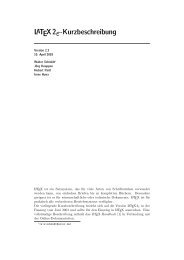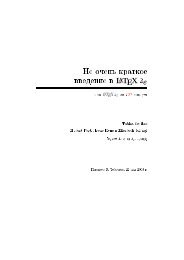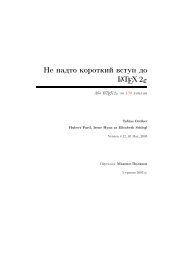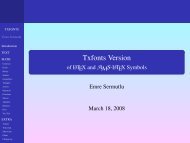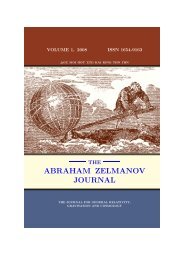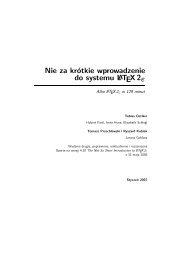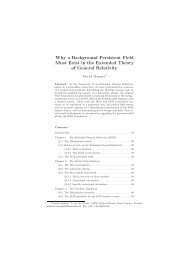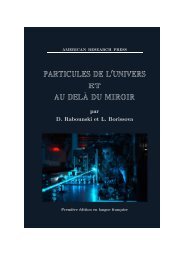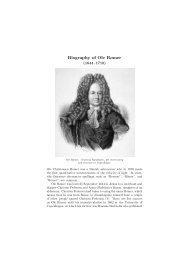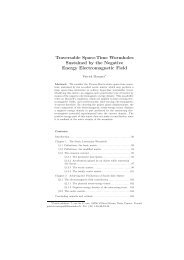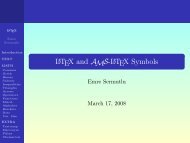The Comprehensive LaTeX Symbol List
The Comprehensive LaTeX Symbol List
The Comprehensive LaTeX Symbol List
You also want an ePaper? Increase the reach of your titles
YUMPU automatically turns print PDFs into web optimized ePapers that Google loves.
Table 285: Defining new log-like symbolsDeclaration function $\newlogsym {p \in P}$ \[ \newlogsym {p \in P} \]\DeclareMathOperator newlogsym p∈P newlogsym p∈P\DeclareMathOperator* newlogsym p∈P newlogsymp∈PIt is common to use a thin space (\,) between the words of a multiword operators, as in“\DeclareMathOperator*{\argmax}{arg\,max}”. \liminf, \limsup, and all of the log-like symbols shownin Table 121 utilize this spacing convention.7.5 Bold mathematical symbolsL A TEX does not normally use bold symbols when typesetting mathematics. However, bold symbols are occasionallyneeded, for example when naming vectors. Any of the approaches described at http://www.tex.ac.uk/cgi-bin/texfaq2html?label=boldgreek can be used to produce bold mathematical symbols. Table 286contrasts the output produced by these various techniques. As the table illustrates, these techniques exhibitvariation in their formatting of Latin letters (upright vs. italic), formatting of Greek letters (bold vs. normal),formatting of operators and relations (bold vs. normal), and spacing.Table 286: Producing bold mathematical symbolsPackage Code Outputnone $\alpha + b = \Gamma \div D$ α + b = Γ ÷ D (no bold)none $\mathbf{\alpha + b = \Gamma \div D}$ α + b = Γ ÷ Dnone \boldmath$\alpha + b = \Gamma \div D$ α + b = Γ ÷ Damsbsy $\pmb{\alpha + b = \Gamma \div D}$ α + b = Γ ÷ D (faked bold)amsbsy $\boldsymbol{\alpha + b = \Gamma \div D}$ α + b = Γ ÷ Dbm $\bm{\alpha + b = \Gamma \div D}$ α + b = Γ ÷ Dfixmath $\mathbold{\alpha + b = \Gamma \div D}$ α + b = Γ ÷ D7.6 ASCII and Latin 1 quick referenceTable 287 on the next page amalgamates data from various other tables in this document into a convenientreference for L A TEX 2ε typesetting of ASCII characters, i.e., the characters available on a typical U.S. computerkeyboard. <strong>The</strong> first two columns list the character’s ASCII code in decimal and hexadecimal. <strong>The</strong> thirdcolumn shows what the character looks like. <strong>The</strong> fourth column lists the L A TEX 2ε command to typeset thecharacter as a text character. And the fourth column lists the L A TEX 2ε command to typeset the characterwithin a \texttt{. . .} command (or, more generally, when \ttfamily is in effect).<strong>The</strong> following are some additional notes about the contents of Table 287:• “"” is not available in the OT1 font encoding.• <strong>The</strong> characters “”, and “|” do work as expected in math mode, although they produce, respectively,“¡”, “¿”, and “—” in text mode when using the OT1 font encoding. 12 <strong>The</strong> following are some alternativesfor typesetting “”, and “|”:– Specify a document font encoding other than OT1 (as described on page 7).– Use the appropriate symbol commands from Table 2 on page 8, viz. \textless, \textgreater,and \textbar.– Enter the symbols in math mode instead of text mode, i.e., $$, and $|$.12 Donald Knuth didn’t think such symbols were important outside of mathematics so he omitted them from his text fonts.100



